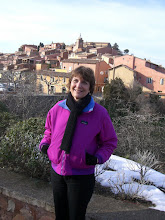
Before anyone jumps to conclusions, we did not take off for Paris, Marseille, Nice, or even Avignon. The word “big,” we discover more and more, is a completely relative term and in this case “the big city” in our part of the Vaucluse means Carpentras, population 26,000. But, when you think about it, that’s ten times bigger than Bédoin and many times the population of nearby Saint-Pierre-de-Vassols which has a mere 467 people! We had heard about the market in Carpentras on Fridays, so despite the coldest temperatures yet, we took the 8:00 a.m. bus from the gare routière for the forty-minute ride.
As soon as we got downtown, we spotted a large group of people milling around in front of the Hôtel-Dieu, a former hospital. A marché aux truffes (truffle market), in addition to the weekly market, was in full swing, with people examining, sniffing, weighing, buying, and selling different shapes and sizes of the black fungus. November to mid-March, it turns out, is the high season and Carpentras is one of the main towns where the expensive product is sold. We knew about truffles from the Périgord in southwestern France, but had no idea that the Vaucluse, along with Alpes-Haute-Provence, la Drôme, and le Gard, account for 80% of the country’s annual production. With a small stand where folks could buy une brouillade aux truffes (frequently just referred to as une omelette aux truffes) and wine, it looked kind of like a marché de Noël only with truffles.

After experiencing several European vacations at and around Christmastime, we are used to what my husband refers to as tourisme à l’abri. “Sheltered sightseeing” in winter is often necessary in order to take refuge from the elements. Often this comes in the form of a nice tea room, so how bad can it be? Anyway, yesterday morning, we were thrilled to have so many opportunites for le lèche-vitrine (“window-shopping”), plus looking through the racks of postcards as well as the stalls of outdoor market vendors, that it took us awhile to notice the feeling of frost beginning to permeate our bones.

Lucky for us, we had spent a few hours in Carpentras the day we returned the car to Avignon about two weeks ago and remembered a tea room on the rue de l’Évêché. Jouvaud, which is a combination pastry shop, chocolate shop, tea room and boutique, has branches in Avignon and, of all surprising places, Tokyo. (I’d love to hear the story of how that came about, but I won't understand it if it's on that Japanese link!) Warming up having coffee, brioche, and pain aux raisins was just what we needed before tackling more of the marché and the rest of the town. Some other people seeking shelter and enjoying Jouvaud told us not to miss the chocolat chaud and the brioche au sucre on our next visit. No problem taking that advice.
Our last stop before catching the bus back home at noon was to pay a visit to Leclerc. Talk about big; picture a Wal-Mart supercenter à la française. You could find everything there—from food to cookware and dishes to office supplies. I commented to my husband that at least ten Shopis could fit inside this one grande surface. As a matter of fact, you might even be able to fit most of downtown Bédoin inside! We'll definitely take another trip to Carpentras before the truffle season is over.




















